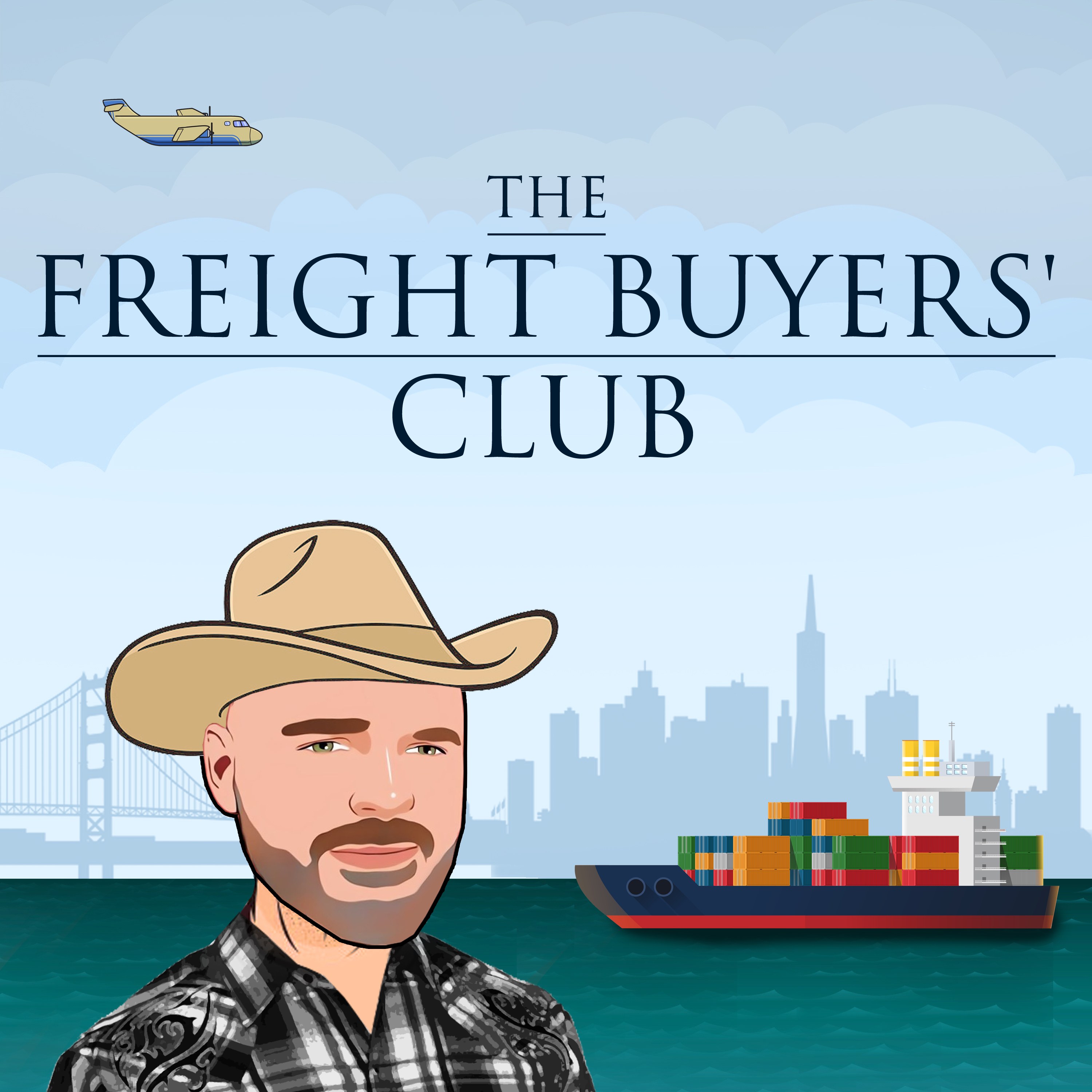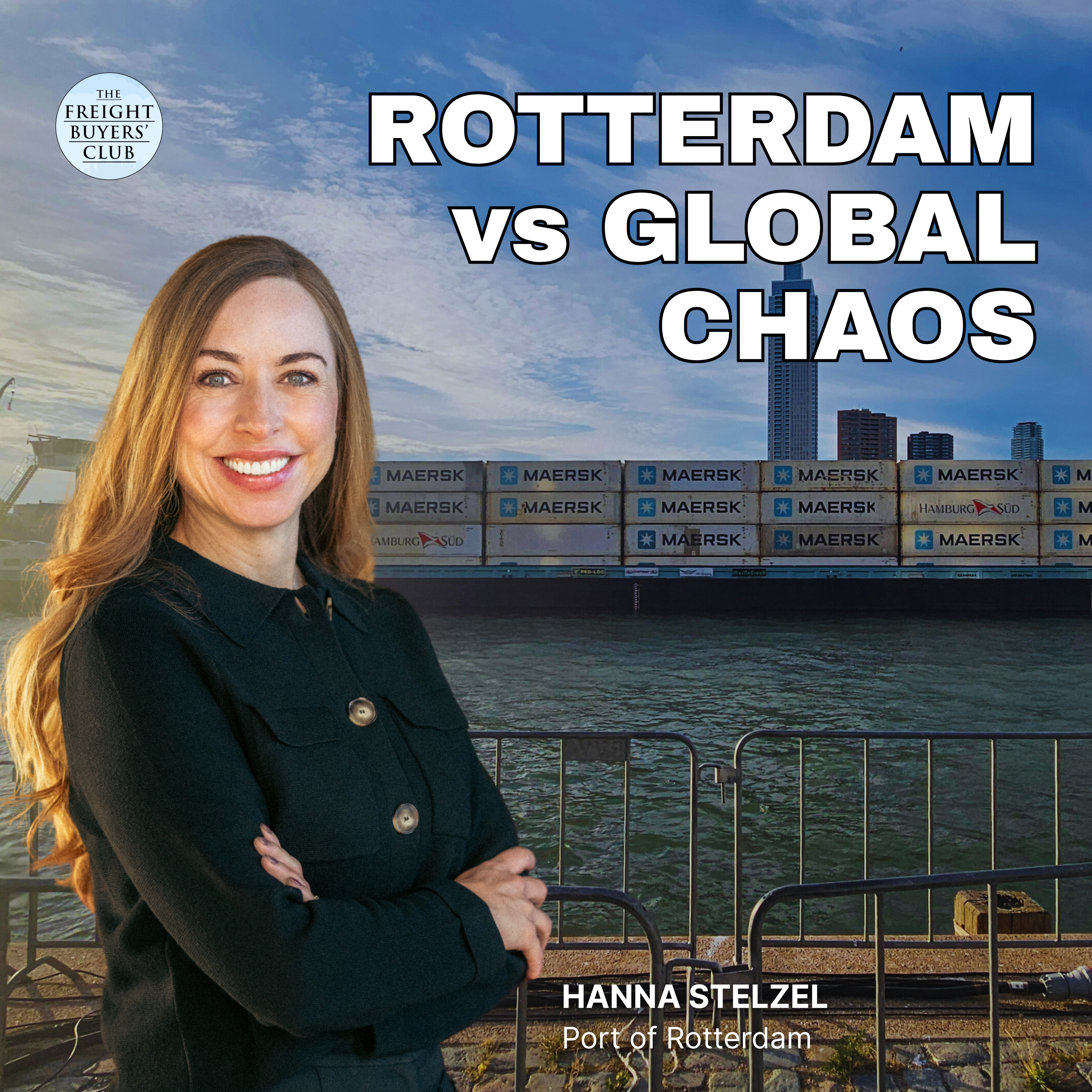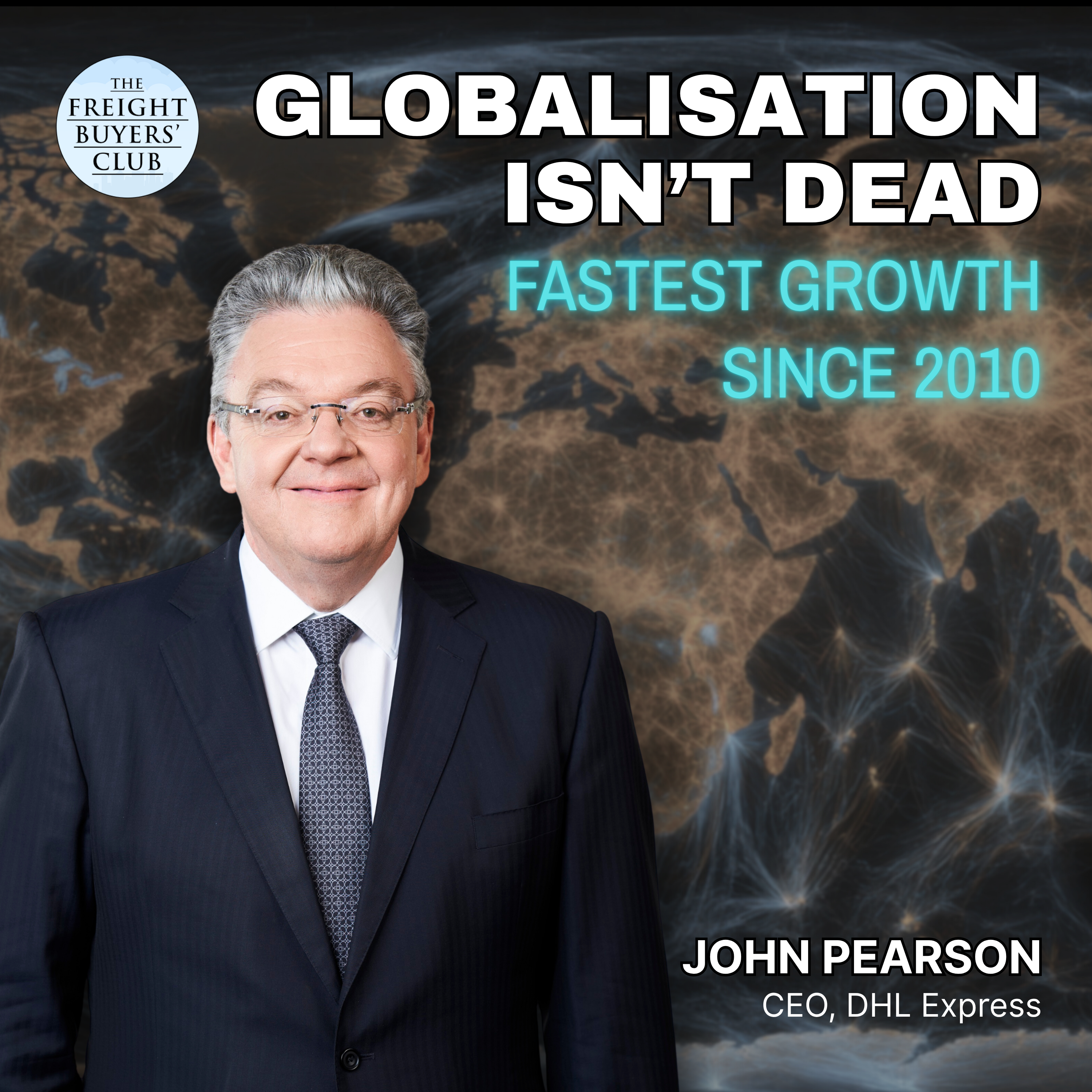Episode Transcript
[00:00:02] Speaker A: Hello, I'm Mike King and you're listening to a specially curated clip from episode 37 of the Freight Buyers Club produced ahead of tariff day on April 2, when the Trump administration is promising to further ramp up trade wars. Here I'm talking to Trade4's multiplier CEO, an ex Customs and Border Protection insider, Cindy Allen. We look at tariffs implemented so far in just over two months since this administration power, and we look ahead to what happens next. If you want an update on de minimis rules, implementation options and timelines, check out the full episode or look out for Cindy discussing this on the Freight Buyers Club YouTube channel and on LinkedIn in a separate clip. And just to timestamp this, we were talking ahead of the 27 March announcement by the Trump administration of 25% tariffs on imported cars and parts. So we don't cover that in this clip. And before I start, of course, big thanks to the America Express for supporting independent journalism. Enjoy. We have new tariffs expected at the start of April from the US Administration, which we're definitely coming back to. But before we we get to that, can you please explain to listeners, Cindy, as simply as possible, which you know, as simply as possible seems like they the wrong word somehow because it's not that simple. But what new tariffs so far have we seen actually implemented since this administration took power? We're only talking about two months ago we had. And when I say which have actually been implemented, what I mean by that is which ones are now in force as opposed to those that were threatened and then withdrawn after a day or two.
[00:01:47] Speaker B: So yeah, there's a lot of noise out there and there's a lot of we're going to do this, we're going to do that. Any whim on social media is reported on and taken as gospel because many times that's the only thing we get in advance of some of these duties. But what we have right now is of course we have regular duty that's always in place. Then we have the 301 duties that were in place from the first Trump administration.
Those are mostly on China, but on a few other countries some of those have been raised in the new Trump administration, although not very much then. We have had steel and aluminum 232 duties on a few countries in the past. Now the new duty is on all steel and aluminum products, so 25% on all steel and aluminum in its primary form and any derivatives. And that's confusing for everyone because let's say you have my favorite a four wheeler with a roll Top bar, that's usually made of steel for the cage support and that roll top bar is now subject to aluminum duties even if you're importing the whole four wheeler. So, so any of the hub, the wheel hubs that are made of aluminum are now subject to duty on the value of those derivative products. So it's extremely confusing for everyone who's trying to import and determine what in my product is made of aluminum, what is made of steel, how much is it valued at and where did it come from? Because that's the other thing you need to know, where that steel and aluminum came from, where it was milled, where it was drawn. So it's, that is probably one of the most complex duties we've had come in. And then you have of course the IPA duty on Canada and Mexico for products that aren't claiming a free trade agreement, USMCA free trade agreement, and then another 10% on China.
So we have 301, we have 232, we have IA duties. It's stacking tariff numbers, stacking tariff duties, one on top of another. That has been extremely complex for the trade industry to actually make sense of. And the custom system in the us the CBP custom system that I ran is having a hard time actually calculating those duties because it's compound rates on multiple levels for the same item. So it's a little bit of a messy process right now, but we're figuring.
[00:04:27] Speaker A: It out just on that example that you gave there about the type of product and how much of it and where it came from as part of an overall product. How do you actually process that and what sort of bureaucracy does it involve? That sounds like an awful lot of form filling.
[00:04:42] Speaker B: It is, it is extremely complex. And you know, I'm a customs broker by trade, have been one for 35 years. And this is challenging for even the most seasoned individuals. So you have the duty rate of the four wheeler, you know, the off road vehicle, you have that. And then you have to, on the same tariff line when you're importing it to the United States, you file an entry with customs and it shows the tariff line which determines the duty. So you have that regular duty. Then you have to calculate, go to the four wheeler manufacturer and say how much of this was aluminum, what pieces, what parts were aluminum, where was that smelted, where was that milled? They may or may not have that. So if they have it, fantastic. We have a different line. We report to customs to show that and pay the appropriate amount of duty, 25% if you don't have it. CBP actually just came out with guidance to say you have to claim the highest duty rate, which is 200% on Russia aluminum. So 200% on that until you come back and tell us where it was actually smelted. So there's a definitely a drive for the manufacturers to understand where the aluminum came from and where it was smelted. And then if it's from China, then you have another line that you list that shows the IIPA duty. Then you have to add all of that up correctly and make sure you're paying the right amount of duty to customs. So customs brokers tend to like the complex things. I think we're regretting that position right now.
[00:06:27] Speaker A: What complexity drives profit, presumably. Right.
Just on that point there.
How all of these things would have been hard to implement and manage for anyone in supply chains with notice. But a lot of this has happened almost, you know, as being said. Right, go ahead. And this is in. This is instant as of my word right now from the Trump administration. That obviously makes it a lot more complex and raises questions about products that are in transit as well.
[00:06:55] Speaker B: Yeah. A lot of companies have ended up paying duty, probably more duty than they needed to because they don't know the information. It's in transit. Some of the rules allowed for in transit, some of them didn't. We know that there's been a lot of capacity issues in some of the areas of the world which have delayed arrivals of vessels. And there's been a lot of consternation around. Well, my vessel left in January and it's not docking until mid March. And now I have to pay these duties because it's outside of the timeframe. And the administration has just come back and said, yes, you're right, stop buying from other areas of the world, which we know is not a reasonable position, but it is what it is and they've, they've been caught, you know, paying duties. And I think that a lot of the freight markets that, that Greg talked about, you know, are starting to recognize costs are going to go up regardless of what happens moving forward. And people in the US Are starting to see that impact our prices and we're starting to see that impact buying patterns in the United States.
[00:08:06] Speaker A: Okay. So far, and we're talking pre April 2nd. What sort of retaliation have we seen from other countries in terms of tariff wars? In the first administration, we saw US Agricultural exporters hit, for example, by China.
[00:08:21] Speaker B: Yeah. So we've seen that again. We've seen China hit ag hard. We've seen them hit oil, coal and gas. We've seen them hit machinery and cars. You know, the normal things that would have a big impact on the US Export market. But we've also seen two other things that I think are sometimes overlooked. One, they have instituted export controls on things like critical minerals. And that has impacted manufacturing in other areas of the world, specifically in the US and some of those critical minerals can't be obtained anywhere else in the levels that are needed and that we see out of China. The other thing is they tend to do investigations on U.S. interests. So we've seen in the press, Google has been looked at. There have been some other companies that have been less forthright in the fact that they're being looked at right now. But I will say that has a huge impact. Anytime the US Takes a step in a trade war, China doesn't just react from a tariff perspective, they react on multiple levels. And that has a huge impact on US companies, especially those with interests in China.
Then for Canada, we're seeing also at a country level, we're seeing tariffs on ag products, on machinery, apparel, footwear. But interesting, we've seen at a province level, we've seen energy exports being looked at and controlled. We've seen, you know, liquor boards remove U.S. liquor from their facilities. So it's kind of a two tier in Canada in that you have the country level actions, then you have province level actions as well. And just over the weekend, EU announced that they were delaying their previously announced tariff retaliation. So we'll see what kind of happens on that. But that's been delayed.
[00:10:18] Speaker A: People are calling the 2nd of April. I say people, Donald Trump is calling the 2nd of April tariff day the big one, Liberation Day. What are we expecting to see announced? And is there anything companies listening to this right now can do to prepare for Liberation Day?
[00:10:36] Speaker B: Liberation Day.
I'm sorry, I just can't with that.
But I think we are seeing a little bit of softening in the approach. And I think there was some talk in the press today about the consideration of a delay. And I think that's driven by, you know, nervousness about the market, about, you know, a lot of individuals understanding how it is impacting the economy in the US and it's starting to show on softening sales and markets that are being affected that, you know, they didn't really think would be affected. But I think to get to the second part of your question, you know, what can people do? And I've been saying in an uncontrollable situation, which is exactly what this is for everyone in international trade. Focus on what you can control. And what you can control is the data that you have on your supply chain, knowing your supply chain. We've been saying that for a decade or more, but it's so much more critical now. And it's not just how the goods are transported. It is where you are sourcing them. What you know, what secondary markets are you in, what duplications do you have in your process so that you know what your entire puzzle looks like and what pieces you can remove or shift around and still have the same picture? And that's really critical, I think, in this era, because nobody knows what's coming. Nobody can predict. Anyone who can predict what's going to happen on April 2nd is lying. We're just taking a best guess because there's no previous example to base us on other than the past two months.
[00:12:26] Speaker A: So we don't know anything about implementation dates, we don't know who's going to be targeted, what type of tariffs, reciprocal tariffs, timelines. Will this be instant? Will there be a planning. No. Okay. We know nothing.
[00:12:38] Speaker B: Well, we've seen, we've seen references to the dirty 15 by the administration, and those are the top 15 countries that have trade deficits with the United States. And we're, we're hearing more about it's just going to be one flat fee instead of on a product by product basis, which would be horrendous to try to, you know, administer. But we're, if something happens, it'll happen on those 15 countries. I think we can all say that. When it'll happen, what will happen? Yeah, it's anyone's guess.


